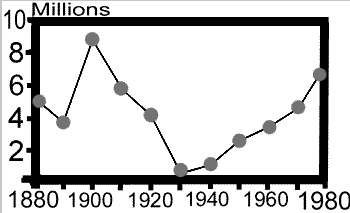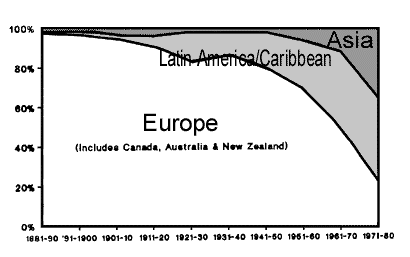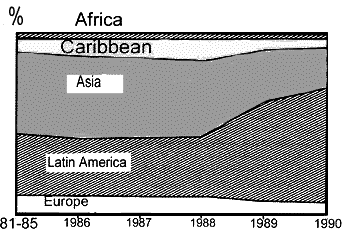The Nation We Are Becoming
Marian Evans and Joseph Fallon, American Renaissance, November/December 1991

For how much longer will the United States have a white majority? Thirty years? Forty years? If American immigration policy remains unchanged, and white fertility rates stay low, your grandchildren will certainly be minorities in their own country, and you, yourself, have a good chance of living out your last years in a nation that is predominantly non-white.
Many Americans do not even realize that in just a few generations their homeland may have a Third-World population, but if pressed to voice an opinion about it in public, they would probably stammer the obligatory praise of “diversity.” They have adopted the official view that a Third World America will be a marked improvement over the self-consciously white nation we once were.
Immigration, the force that gave America its cultural identity, is now the force that is driving its transformation. Only in the last few decades has America’s traditional commitment to its European heritage been tossed aside, and millions of non-whites been allowed to pour into the country. No government action is likely to affect the future of our country more profoundly than decisions about who will populate America; yet immigration policy is now made in complete disregard of the wishes of the current majority and runs directly counter to America’s obvious needs.
The graph below shows the effect of two centuries of immigration on the racial composition of the United States. It is interesting to note that in the early years of the Republic, blacks, at nearly 20 percent, were a larger proportion of the population than at any time since. After the slave trade was banned in 1808, their numbers grew only by natural increase, and their proportion dropped to an all-time low of just under 10 percent in the 1920s and 1930s.
The white percentage of the population, boosted by high, virtually all-white immigration around the turn of the century, rose to its highest level of around 90 percent in the 1930s and 1940s. How this number was quickly reduced to the 75 percent figure of today is explained by the below graphs.

Graph 2, above, shows total immigration to the United States, by decade, since 1881. It shows no long-term pattern, since immigration was greatly reduced by the Depression and the Second World War. Since the 1950s, however, immigration has continued to climb, and more immigrants came to this country during the last decade than in any previous decade save that of the 1900s.

Graph 3, immediately above, represents the racial composition of immigration for almost the same historical period. It shows that just as immigration was surging after the war, the mix of immigrants changed dramatically. As a result of new immigration laws in the 1950s and 1960s, the proportion of whites coming to America plummeted. Graph 4, immediately below, is a continuation of Graph 3, but on a finer time scale. It shows that in the last decade, when immigration was climbing to near-record highs, white immigration dwindled to almost nothing. During that decade, even black immigrants from the Caribbean and Africa — hardly traditional sources of American immigration — outnumbered arrivals from Europe.

Graph 5, immediately below, shows the number of legal immigrants who came to America in 1990 from the top eight countries of origin. Not a single one of these nations has a white population. It is this huge wave of non-white immigration that brings us back to the question implied by graph 1. How quickly will whites become a minority in America . . . and how small a minority will it be?
The downward slope of the line labeled “White” is likely to get much steeper, as people fleeing Third-World misery pour across our borders and continue to have babies at Third-World rates after they get here. Although whites are still some 75 percent of the population, they make up only 69 percent of the population under age 18. Non-whites are already a majority of all children in Washington, D.C. (90 percent), Hawaii (75.5 percent), and New Mexico (67 percent). They are over 40 percent of all children in California (46.4), Florida (46.4), Mississippi (47.6), and Texas (47.1).
Children are the future of any society, and the United States is rushing towards a non-white future at ever-increasing speed. A hundred years from today, whites and European culture could be furtive remnants on a continent they once dominated; as soon as non-whites become the majority, it is not likely that immigration or other policies will ever be changed to reverse today’s trends.
Illegal Immigration
These graphs cover only legal immigration. Although there are still hundreds of thousands of American troops guarding Europe against an increasingly improbable invasion from the East, at any one time there are no more than 500 guards patrolling our border with Mexico. Every year they manage to catch about one million people trying to break into America. How many others manage to slip through their net is anyone’s guess.
In 1986, in an astonishing act of capitulation, the United States “solved” its illegal immigrant problem by granting amnesty to all illegals who could prove they had been in America since 1982. In effect, our government decided to reward anyone who had been able to break our laws continuously since that date. In 1989, 492,000 people were granted amnesty, and in 1990 the figure was 880,372. The Immigration and Naturalization Service expects that more than 2,000,000 illegals will eventually be granted amnesty under the law.
In both 1989 and 1990, about 70 percent of the people given amnesty were Mexican. This helps account for the very high figure for Mexicans in graph 3. Amnesty effectively quadrupled Mexican immigration for that year.
What has been a huge gift to Mexico has hardly been a bargain for us. The state of California, which got the largest share of amnestied illegals, discovered that its newly-legal residents had an average of four years of education and that 80 percent did not speak English well enough to hold a job. These former law-breakers can now sponsor immigration of relatives they left behind in Mexico.
At the same time, the fact of having once granted amnesty suggests that the United States could very well grant it again in the future. Mexicans certainly seem to think so. The border patrol reports a sharp increase in apprehensions of entire families trying to make the crossing together. This is a departure from the usual pattern of illegal immigration by unaccompanied men. Generally, illegals bring their wives and children only when they intend to settle permanently.
Disappearing America
Whether by design or by accident, the United States of previous decades is disappearing. The “diversity” that is replacing it is said to be a blessing for the whites who would otherwise have to live only with their own kind. Curiously, only white people appear to be qualified to receive or appreciate this blessing. No non-white nation is said to be plagued by a troublesome homogeneity that must be put right by importing people who are as different as possible from its current residents. If the United States were sending its poorest, least educated people to Japan or even to Mexico, no one could trick the Japanese or the Mexicans into “celebrating diversity” or thinking they had been “culturally enriched.”

In November of 1988, the New York City public utility, Con Edison gave an English-language proficiency test to 7,000 applicants for entry-level jobs. This was an elementary test to see whether applicants knew enough English to handle the simplest jobs. Only 4,000 passed.
Some large employers have given up trying to hire people who already speak English; they try to teach it to them on the job. Motorola, which has large operations in Illinois and California, holds classes at company expense and on company time. By 1992, it expects to have spent $30 million on an English-teaching program it started in 1986.
At least Motorola and Con Edison have some kind of commitment to English, if only as a means of business communication. Increasing numbers of Americans — teachers, bureaucrats, social activists, immigrants — have no loyalty to English at all and denounce any recognition of its primacy as “racism” and “cultural chauvinism.” Government policies, immigrant demands, and majority apathy are rapidly undermining the central, unifying role of English.
In the past, when almost all immigrants were European, they learned English as a matter of course. There was no question but that English was the national tongue and that those who did not speak it had better learn. It was the immigrant who had to change, not America. No more. The United States is unique among nations in the extent to which it has abandoned even the pretense of asking foreigners to conform to its own standards. Just as immigration policy itself is working revolutionary change on the racial composition of the United States, official recognition of foreign languages is working the same change on America’s cultural landscape.
The Babel of Instruction
Although attempts to unthrone English have succeeded in many areas, the most obvious victory has been in the classroom. “Bilingual education,” which began in 1968 as a way to teach Hispanic students enough English to keep up in school, has grown into a massive undertaking to teach children academic subjects in their own languages.
Some local school districts still refuse to teach in any subject but English, but districts that must attempt to educate large numbers of immigrants inevitably bow to activist pressure and introduce “bilingualism.” In some schools, the goal is still to shift immigrant children gradually into an all-English curriculum, but as the foreign-language-instruction interests gain power, the goal changes. Now “bilingual education” often means education in any language but English and even the unabashed promotion of the “cultural heritages” of foreigners — this, in public schools and at taxpayer expense.
Just as “equal opportunity” now means the reverse of its original meaning, “bilingual” has been twisted into another liberal code word for its precise opposite. “Bilingual” education can now be monolingual education, so long as it is in a foreign language.
Astonishing as it may seem, public school instruction in the United States is now carried out in 153 different languages. In New York City, during the 1988-89 school year, students were taught in 82 languages, including such exotica as Kpelle, Nyanja, Twi, Gurma, Ewe, and Cham (see box for a full list). A child who speaks absolutely any obscure language under the sun has a right to demand instruction, in the public schools, in his native tongue. Presumably, if this means that Twi-speaking or Ewe-speaking teachers have to be imported from wherever it is that people speak Twi or Ewe, so be it.
In fact, Ewe is spoken in parts of Togo, a small country in West Africa. The Togolese, sensible folk, do not offer public instruction in Ewe. They teach school in French, a language that American liberals would denounce as that of the former colonizer, but one that the Togolese recognize as having certain advantages over Ewe. One is that it can be written down. Since Ewe-speakers never developed writing, one wonders just what New York City does about Ewe textbooks.
The Los Angeles public school district has the same language policy as New York, but goes even further. Fully two thirds of its students come from homes in which English is not spoken, and in one recent year, Los Angeles offered instruction in 103 languages. PTA meetings, in schools that still manage to have them, are madhouses of clashing languages and competing interpreters.
As bad as all this sounds, it could get worse. It is not yet possible for Ewe-speakers, for example, actually to get a diploma. In New Jersey, they would have to choose from one of only twelve languages in which to take the test of basic knowledge necessary to graduate from high school. But this does mean that someone could march into an employer’s office brandishing a New Jersey diploma and speaking no language but Arabic! In Oklahoma, there are public schools in which the language of instruction is Cherokee.
With all this “bilingual” teaching going on, there is a huge demand for people to do it. Even when non-white children are taught in English, the fad for same-race “role models” puts an effective hiring freeze on whites who speak only English. All across California, “bilingual” teachers get a several-thousand-dollar premium ($5,000 a year in Los Angeles) over the usual kind, and recruitment drives bring in teachers from all over the world.
Everyone recognizes that “bilingualism” is crushingly expensive, but funding schemes only perpetuate it. Since California schools get an extra $350 a year in state and federal money for each student with “limited English” the more such students they have the better. The “bilingual” interests therefore want as many non-English speaking students as possible, and may try to keep them speaking “limited English” for as long as possible.
Spanish is especially well entrenched. In Los Angeles, there are plenty of schools at which 90 percent or more of the students are Hispanic. They live in an entirely Spanish-speaking environment that includes Spanish-language magazines, newspapers, radio and television. Public education does nothing more than confirm their alien character.
The standard text in the Los Angeles “bilingual” community is Empowering Minority Students, by Jim Cummins. He argues that instruction in languages other than English is a blow against injustice and an act of rebellion against white domination. He writes that the way to “empower” non-white children is “consciously [to] challenge the power structure both in their classrooms and schools and in the society at large.” At least the English-speakers can’t say they weren’t warned.
Bilingualism got a new twist in Miami, recently, when a candidate for the school board explained that “bilingual” education means that “Anglos” must learn Spanish. For anyone who didn’t care for this, he suggested, there was always neighboring Broward County, which does not yet have a Spanish-speaking majority. As Maurice Ferre, former mayor of Miami, put it several years ago, “Within ten years there will not be a word of English spoken — English is not Miami’s official language — one day residents will have to learn Spanish or leave.” So much for bilingualism.
Into Society at Large
Although foreign-language instruction in the classroom is only the best known example of the assault on English, the campaign knows no boundaries. Philadelphia and Florida now offer civil service examinations in Spanish. Chinese- and Vietnamese-speakers are demanding the same treatment, and California may soon offer tests in Spanish. People who call the Department of Motor Vehicles will be even less likely to get someone who speaks English than they are now.
Even though traffic tickets, storm warnings, and accident reports are (still) written in English in most parts of the country, there are only 11 states left out of 50 that make drivers take their written test in English. Some states offer the test in as many as a dozen languages.
Perhaps the greatest absurdity of all is foreign-language ballots. It might be possible to make a case for foreign-language education that does not completely do away with the concept of nationality, but a ballot in Chinese makes a mockery of the idea that being an American citizen means anything at all. Theoretically, there is still a legal requirement that naturalized citizens be able to speak English, but it has about as much force today as does the Tenth Amendment.
Whatever the legal status of English, the current invasion of foreigners has immense day-to-day consequences that are as costly as they are little-known. In every locale where there is a concentration of Hispanics, police find a concentration of Spanish-speaking criminals. For a policeman who doesn’t speak Spanish, this is both a frustration and a danger. Not only is he unable to get information about a crime, he may be unable to calm a dangerous gunman or understand a shouted warning from a bystander. Suspects and witnesses may disappear because they can’t be questioned.
Police departments from California to Florida to Ohio are desperately trying to teach their officers Spanish or hire people who speak it. In the mean time, they make do with interpreters or simply tell patrolmen to try to find someone on the spot who will interpret. This takes time. A study by the Westminster (CA) Police Department found that language problems force officers to spend 30 percent more time on calls than they would if everyone spoke English. The Placentia (CA) department has developed a semester-long Spanish course that includes a two-week trip to Mexico. All this costs a great deal of money.
As with teachers, the demand for Spanish-speakers is so high that departments must pay extra to get them. Police in Los Angeles, San Jose (CA), and Albuquerque (NM) already get bonus pay if they speak Spanish, and the trend is picking up elsewhere. Firemen and para-medics are demanding extra pay if they speak Spanish. The FBI and the Drug Enforcement Administration already pay Spanish-speakers up to 25 percent more than English-speakers.
Whether or not they offer premiums, police departments must run ruthless affirmative action programs simply to get police who can talk to criminals. The police chief in Santa Ana (CA) wanted half of all officers hired in 1990 to be bilingual. He managed to get only 40 percent. “This year, we increased the goal to 100 percent,” he says. Likewise, the Garden Grove (CA) force didn’t quite meet its goal, last year, of filling half its openings with non-whites, so it has raised its sights to two-thirds this year. Of course, this means that native-born whites, through no fault of their own, have virtually no chance of getting a police job.
Asians are less crime-prone than Hispanics, and don’t commit much street crime. Nevertheless, they pose some of the most thorny language problems of all. Hong Kong gangs known as Triads have now pushed the Mafia aside and have taken over the heroin trade. Hong Kong will be handed back to China in 1997, and the Triads do not plan to stick around and wait for stern Chinese justice. They are moving operations overseas, mainly to Canada and the United States. They have codes of silence, revenge, and loyalty that make the Mafia look like boy scouts. American police have had virtually no success in infiltrating them.
Vietnamese gangs, often made up of ethnic Chinese, are just as much of a problem. With names like Flying Dragons, Ghost Shadows, and Born to Kill, they conduct savage warfare on each other and prey on immigrant Vietnamese. They, too, are nearly impossible to infiltrate.
Language poses further difficulties whenever non-English-speakers go to trial. Naturally, criminal defendants must be given interpreters, at public expense. The state of California alone spent more than $16 million on criminal-trial interpreters in 1988 — twice as much as it did five years earlier. It’s not enough. The low rates the court pays are a fraction of what a competent interpreter normally gets, so many cases bog down in a morass of mistranslated testimony.
Exotic Diseases
Another little-known language problem that non-white immigration brings with it is strange new demands on the medical profession. Sick immigrants who can’t talk to doctors slow down the pace of treatment for everyone. Hospitals and Medicare bureaucrats are hunting for interpreters and “bilinguals” just as hard as schools and police are. Sometimes the problems are cultural as much as linguistic. Many Asians are too squeamish to talk about sex, and refuse to be told about AIDS or venereal disease.
Even more frustrating are immigrants with psychoses. One study of Hmong tribesmen, who came to America from Cambodia after the Vietnamese war, found that 43 percent had serious psychiatric disorders. People fleeing wars in Central America have equally high rates of mental illness. No one has much of an idea how to treat these people.
One East Asian disease called “koro” has the doctors completely baffled. Men and women become paralyzed with the fear that their nipples or penises will retract into their bodies and kill them. How do you treat a Laotian peasant who speaks no English and is convinced that he is about to be stabbed to death by his own penis?
Fighting Back?
Is America destined to smother in a babble of mutual incomprehension? People who want to prevent that have two approaches. One is to limit immigration or, failing that, to make newcomers speak English. Both measures are going nowhere. Last year, Congress raised immigration ceilings so that the 1990s may well see more legal immigration to this country than any other decade. The proposal that English-speakers be given some kind of priority was voted down as “racist” and “chauvinist.”
Organizations like U.S. English are trying to promote the idea that America should have one official language. At one level they appear to have had some success. Despite opposition from the usual liberal forces, eighteen states have enacted laws establishing English as their official language. These laws change nothing. Drivers can still take their exams in Portuguese, and voters can still cast ballots in Cantonese. Hispanic activists, who like to point out that the United States already has more Hispanics than Venezuela does, are demanding that government business be conducted in Spanish — or at least with simultaneous interpretation. The latest liberal craze is to insist that non-citizens be given the right to vote.
Nothing is more vital to a culture or to a people than its language. The non-English speakers know this, of course, and that is why they are so vehement about keeping their own languages. They do not want to become American; they want America to become what they are. Without English, America will cease to be American. A people that allows its language to be supplanted will allow itself to be supplanted.















